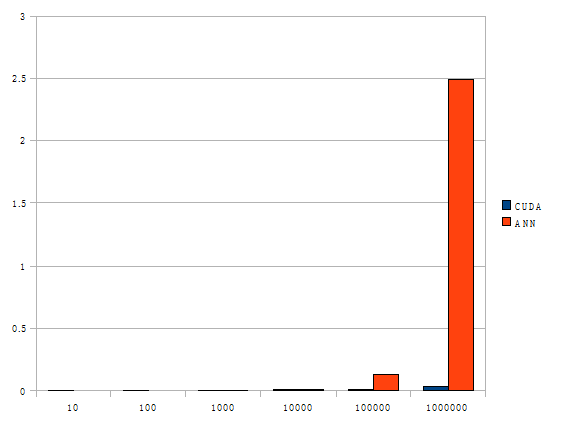kNN(k Nearest Neighbor)是常用的群集算法(Cluster Algorithm)用于空间搜索。目前最快的kNN方法莫过于KDTree的版本,不过基本上都是CPU的比如ANN C++ Library。对于GPU来说,实现加速结构比较复杂,因为没有栈所以无法递归,而且执行资源有限,不能像CPU一样舒舒服服的顺序执行。
为了方便起见我直接用komrade粘合C++与CUDA,下面是测试程序的代码。
#include <komrade/device_vector.h>
#include <komrade/transform.h>
#include <komrade/range.h>
#include <komrade/copy.h>
#include <komrade/fill.h>
#include <komrade/sort.h>
#include <komrade/replace.h>
#include <komrade/functional.h>
#include <iostream>
#include <iterator>
#include <math.h>
#include <memory>
#include <boost/timer.hpp>
using namespace std;
#include <ANN/ANN.h>
#pragma comment(lib,"ANN.lib")
struct dist
{
dist(float qx, float qy, float qz) : x(qx), y(qy), z(qz)
{
}
float x,y,z;
__host__ __device__ float operator()(const float3& p) const
{
float a = p.x - x;
float b = p.y - y;
float c = p.z - z;
return a*a + b*b + c*c;
}
};
int main(int argc, char* argv[])
{
if( argc < 2 )
return -1;
int N = 0;
sscanf(argv[1],"%d",&N);
boost::timer Stopwatch;
ANNpointArray ANNPh = annAllocPts(N,3);
komrade::host_vector<float3> Ph(N);
komrade::device_vector<int> Idx(N);
komrade::device_vector<float> Dist(N);
for(int i=0; i<N; ++i)
{
float x = (float)rand() / (float)RAND_MAX;;
float y = (float)rand() / (float)RAND_MAX;;
float z = (float)rand() / (float)RAND_MAX;;
Ph[i].x = x;
Ph[i].y = y;
Ph[i].z = z;
ANNPh[i][0] = x;
ANNPh[i][1] = y;
ANNPh[i][2] = z;
if( N < 32 )
printf("<%f %f %f>\n",x,y,z);
Idx[i] = i;
}
cout<<fixed<<"Generate Data Used "<<Stopwatch.elapsed()<<endl;
Stopwatch.restart();
float QueryPos[3];
QueryPos[0] = (float)rand() / (float)RAND_MAX * 0.1f + 0.5f;
QueryPos[1] = (float)rand() / (float)RAND_MAX * 0.1f + 0.5f;
QueryPos[2] = (float)rand() / (float)RAND_MAX * 0.1f + 0.5f;
if( N < 32 )
printf("[%f %f %f]\n",QueryPos[0],QueryPos[1],QueryPos[2]);
komrade::device_vector<float3> Pd = Ph;
cout<<fixed<<"Copy Data Used "<<Stopwatch.elapsed()<<endl;
Stopwatch.restart();
komrade::transform(Pd.begin(), Pd.end(), Dist.begin(), dist(QueryPos[0], QueryPos[1], QueryPos[2]));
komrade::sort_by_key(Dist.begin(), Dist.end(), Idx.begin());
cout<<fixed<<"Sort Data by CUDA Used "<<Stopwatch.elapsed()<<endl;
Stopwatch.restart();
ANNkd_tree ANNTree(ANNPh,N,3);
ANNidx ANNIdx[1];
ANNdist ANNDst[1];
ANNTree.annkSearch(QueryPos,1,ANNIdx,ANNDst);
cout<<fixed<<"Sort Data by ANN Used "<<Stopwatch.elapsed()<<endl;
if( N < 32 )
{
copy(Dist.begin(), Dist.end(), ostream_iterator<float>(cout," "));
cout<<endl;
copy(Idx.begin(), Idx.end(), ostream_iterator<int>(cout," "));
}
return 0;
}
#include <komrade/transform.h>
#include <komrade/range.h>
#include <komrade/copy.h>
#include <komrade/fill.h>
#include <komrade/sort.h>
#include <komrade/replace.h>
#include <komrade/functional.h>
#include <iostream>
#include <iterator>
#include <math.h>
#include <memory>
#include <boost/timer.hpp>
using namespace std;
#include <ANN/ANN.h>
#pragma comment(lib,"ANN.lib")
struct dist
{
dist(float qx, float qy, float qz) : x(qx), y(qy), z(qz)
{
}
float x,y,z;
__host__ __device__ float operator()(const float3& p) const
{
float a = p.x - x;
float b = p.y - y;
float c = p.z - z;
return a*a + b*b + c*c;
}
};
int main(int argc, char* argv[])
{
if( argc < 2 )
return -1;
int N = 0;
sscanf(argv[1],"%d",&N);
boost::timer Stopwatch;
ANNpointArray ANNPh = annAllocPts(N,3);
komrade::host_vector<float3> Ph(N);
komrade::device_vector<int> Idx(N);
komrade::device_vector<float> Dist(N);
for(int i=0; i<N; ++i)
{
float x = (float)rand() / (float)RAND_MAX;;
float y = (float)rand() / (float)RAND_MAX;;
float z = (float)rand() / (float)RAND_MAX;;
Ph[i].x = x;
Ph[i].y = y;
Ph[i].z = z;
ANNPh[i][0] = x;
ANNPh[i][1] = y;
ANNPh[i][2] = z;
if( N < 32 )
printf("<%f %f %f>\n",x,y,z);
Idx[i] = i;
}
cout<<fixed<<"Generate Data Used "<<Stopwatch.elapsed()<<endl;
Stopwatch.restart();
float QueryPos[3];
QueryPos[0] = (float)rand() / (float)RAND_MAX * 0.1f + 0.5f;
QueryPos[1] = (float)rand() / (float)RAND_MAX * 0.1f + 0.5f;
QueryPos[2] = (float)rand() / (float)RAND_MAX * 0.1f + 0.5f;
if( N < 32 )
printf("[%f %f %f]\n",QueryPos[0],QueryPos[1],QueryPos[2]);
komrade::device_vector<float3> Pd = Ph;
cout<<fixed<<"Copy Data Used "<<Stopwatch.elapsed()<<endl;
Stopwatch.restart();
komrade::transform(Pd.begin(), Pd.end(), Dist.begin(), dist(QueryPos[0], QueryPos[1], QueryPos[2]));
komrade::sort_by_key(Dist.begin(), Dist.end(), Idx.begin());
cout<<fixed<<"Sort Data by CUDA Used "<<Stopwatch.elapsed()<<endl;
Stopwatch.restart();
ANNkd_tree ANNTree(ANNPh,N,3);
ANNidx ANNIdx[1];
ANNdist ANNDst[1];
ANNTree.annkSearch(QueryPos,1,ANNIdx,ANNDst);
cout<<fixed<<"Sort Data by ANN Used "<<Stopwatch.elapsed()<<endl;
if( N < 32 )
{
copy(Dist.begin(), Dist.end(), ostream_iterator<float>(cout," "));
cout<<endl;
copy(Idx.begin(), Idx.end(), ostream_iterator<int>(cout," "));
}
return 0;
}
下面是性能分析对比,可以看到CUDA版本在大量点的情况下还是非常有优势的,不过在纯RenderFarm就用不上了,恐怕只能在装备有G80以上芯片的桌面环境或者工作站上执行。测试环境如下,
- Intel E5200@2.9G
- Apacer 2Gx2
- 9800GT 512M
- CUDA 2.2, komrade 0.9
| 10 | 100 | 1000 | 10000 | 100000 | 1000000 | |
| CUDA | 0.003 | 0.003 | 0.00300 | 0.007 | 0.012 | 0.038 |
| ANN | 0.000 | 0.000 | 0.00100 | 0.008 | 0.131 | 2.490 |
极其明显的,当排序数目数量级超过10e5的时候,CUDA显示出了巨大的速度优势。数目比较少的时候还是CPU的比较快速。
